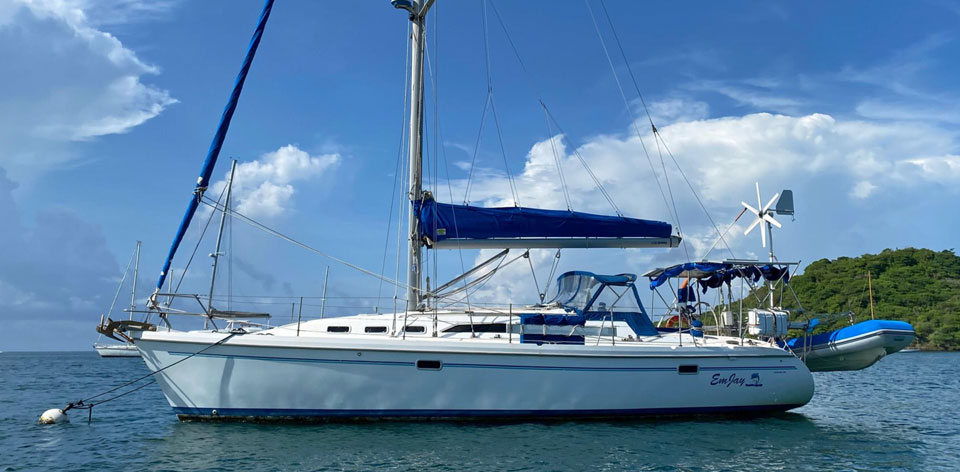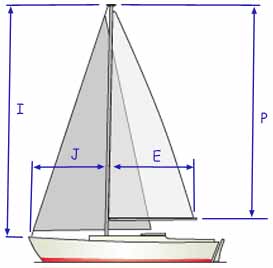- Home
- Cruising Yachts 35' to 40'
- Catalina 380 Sailboat Specs
The Catalina 380 Sailboat
Specs & Key Performance Indicators
The Catalina 380 sailboat was designed by American naval architect Gerry Douglas and built by Catalina Yachts in California, USA.
 The Catalina 380
The Catalina 380Published Specification for the Catalina 380
Keel & Rudder Configuration: Fin keel with spade rudder
Hull Material: Fiberglass
Length Overall: 38'5" (11.7m)
Waterline Length: 32'5" (9.88m)
Beam: 12'4" (3.76m)
Draft: see below*
Rig Type: Masthead sloop
Displacement: 19,500 lbs (8,845 kg)
Ballast: 7,300 lbs (3,311 kg)
Water Tank Capacity: 95 gallons (360 liters)
Fuel Tank Capacity: 28 gallons (106 liters)
Hull Speed: Approximately 7.6 knots
Designer: Gerry Douglas
Builder: Catalina Yachts
Year First Built: 1997
Year Last Built: 2001
Options & Alternatives
*Two keel options were available for the Catalina 380:
- A Wing Keel version drawing 4'10" (1.47m)
- A Fin Keel version drawing 6'9" (2.06m)
There were two further developments of the 380 aimed to build on the success of the Catalina 380 by incorporating feedback from owners and advancements in sailboat design:
- Catalina 387: This model was introduced as an evolution of the Catalina 380. It featured a slightly longer hull and some updated interior and exterior design elements, including a redesigned cockpit and improved deck layout.
- Catalina 390: Another variant, the Catalina 390, offered additional refinements and enhancements over the 380, such as upgraded rigging options and more luxurious interior finishes.
Sail Areas & Rig Dimensions

Rig Dimensions
- I: 50'11" (15.52m)
- J: 13'8" (4.16m)
- P: 44'10" (13.66m)
- E: 15'8" (4.78m)
Sail Areas
- Mainsail Area: 351.2ft² (32.6m²)
- Fore Triangle Sail Area: 373.5ft² (34.7m²)
- Total Sail Area (100% Fore + Main Triangles): 724.7ft² (67.3m²).
Published Design Ratios
The Key Performance Indicators (KPIs)
- Sail Area/Displacement Ratio (SA/D): 16.31
- Ballast/Displacement Ratio: 36%
- Displacement/Length Ratio (D/L): 249
- Comfort Ratio: 26.3
- Capsize Screening Formula (CSF): 2.0
The following analysis of the primary design ratios gives an indication of the boat's likely sailing characteristics, but see the 'Notes of Caution' that follow below:
1. Performance: With a SA/D ratio of 16.31, the Catalina 380 falls within the 'reasonably good performance' range. It suggests a good balance between sail power and displacement, making it capable of respectable speed and handling in various wind conditions.
2. Stability: The 36% Ballast/Displacement Ratio indicates a significant percentage of weight dedicated to the keel. This suggests the Catalina 380 is designed for good stability and stiffness. It should be able to handle stronger winds and rougher seas comfortably compared to a lighter boat.
3. Displacement: A D/L of 249 places the Catalina 380 firmly in the 'Moderate Displacement' category. This means it has a moderate weight for its length, offering a balance between performance and comfort. The 380 should be relatively easy to handle and provide a comfortable motion in a seaway.
4. Comfort: A Comfort Ratio of 26.3 suggests the Catalina 380 leans towards the 'somewhat lively' end of the spectrum within the 'coastal cruiser with moderate stability' range. While it should offer a generally comfortable ride, it might be more noticeable in terms of motion compared to heavier, purpose-built bluewater boats.
5. Bluewater Capability: With a CSF of 2.0, the Catalina 380 sits right on the threshold for bluewater suitability. While it technically meets the criteria, it suggests that careful consideration should be given to crew experience and weather conditions before venturing far offshore.
Overall: The Catalina 380's design ratios point to a versatile sailboat, well-suited for coastal cruising and capable of venturing offshore with proper preparation and caution. It strikes a balance between performance, stability, and comfort, making it a popular choice for cruising families.
Here's how to calculate the KPIs yourself - without having to wrestle with the mathematics...
Design Ratios: Notes of Caution...
- The Sail Area/Displacement Ratio (SA/D): This ratio provides an estimate of the sail power relative to the boat's weight, which can indicate potential speed in various wind conditions. But it doesn't account for the efficiency of the sail plan, the rigging, or the skill of the crew. Real-world performance can vary significantly based on these factors.
- The Ballast/Displacement Ratio (B/D): This ratio gives an idea of the boat's stability and stiffness, which is crucial for handling and safety. But it doesn't consider the distribution of the ballast or the hull shape, both of which can greatly affect stability. A high B/D ratio alone doesn't guarantee a stable boat if the ballast is poorly distributed.
- The Displacement/Length Ratio (D/L): This ratio helps predict the boat's speed potential and its behaviour in different sea conditions. But it doesn't account for the hull design or the boat's overall weight distribution. Two boats with the same D/L ratio can perform very differently if their hull shapes are different.
- The Comfort Ratio (CR): This ratio estimates the boat's motion comfort in a seaway, which is important for long passages. But it doesn't consider the boat's interior layout, which can also affect comfort. Additionally, personal tolerance to motion varies, so a boat that is comfortable for one person might not be for another.
- The Capsize Screening Formula (CSF): This formula assesses the likelihood of a boat capsizing in heavy seas, which is critical for offshore safety. But it doesn't take into account the boat's handling characteristics or the skill of the crew. A boat with a low CSF can still capsize if poorly handled in severe conditions.
General Limitations
- Static Nature: These ratios are static measurements and don't account for dynamic factors like wave action, wind gusts, or crew actions.
- Simplification: They simplify complex interactions into single numbers, which can be misleading. Real-world performance is influenced by a multitude of factors that these ratios can't fully capture.
- Context: The context in which the boat is used (e.g., coastal cruising vs. offshore racing) can greatly affect how these ratios should be interpreted.
In summary, while these ratios provide valuable insights into the theoretical performance characteristics of a sailboat, they should be used as part of a broader assessment that includes practical experience, sea trials, and expert advice.
This article was written with the assistance of Gemini, a large language model developed by Google. Gemini was used to gather information, summarize research findings, and provide suggestions for the content and structure of the article.
Recent Articles
-
Hans Christian 43: Classic Bluewater Cruiser & Liveaboard Sailboat
Dec 10, 25 04:37 AM
Explore the Hans Christian 43: a legendary heavy-displacement, long-keel sailboat. Read our in-depth review of its specs, design ratios, and suitability for offshore cruising and living aboard. -
Planning Your Sailboat Liveaboard Lifestyle: An Ocean Sailor's Guide
Dec 06, 25 05:18 AM
Seasoned sailors share their methodical risk analysis for planning a secure Sailboat Liveaboard Lifestyle, covering financial, property, and relationship risks. -
Marine Cabin Heaters: The Expert’s Guide to Comfort & Safety at Sea
Dec 05, 25 06:52 AM
Choose the best Marine Cabin Heaters for your vessel. Expert advice on diesel, paraffin, and hot water systems for year-round cruising comfort.












